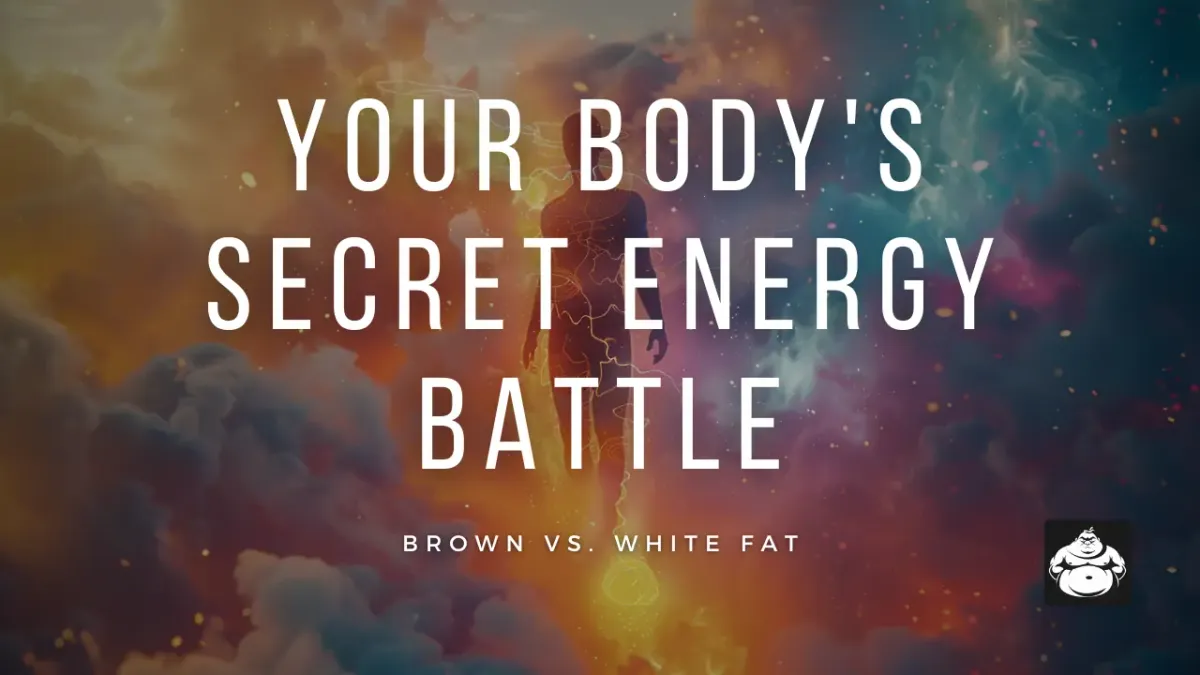Exhaling Fat: The Surprising Truth About Weight Loss
Often overlooked, the path of fat burning reveals surprising truths about weight loss—what really happens to the fat you shed?

When your body burns fat, you might wonder where it actually goes. As it turns out, the process involves breaking down stored triglycerides into usable energy, resulting in byproducts like carbon dioxide and water. Most of this carbon dioxide is exhaled, while water leaves your body through sweat and urine.
Nevertheless, there's more to this process than just simple energy conversion. Understanding the complex details of fat metabolism could reveal surprising realizations about your weight loss journey and its challenges. What else happens that you might not have contemplated?
Fat's Essential Functions: More Than Just Energy Storage
Fat plays an essential role in your body by serving as an energy reserve, supporting hormone production, and protecting your organs.
Your body stores fat mainly as triglycerides in adipose tissue, which you can tap into for energy when needed. This stored body fat is vital for maintaining your energy levels, especially in periods of fasting or intense exercise.
Fat also helps regulate hormones, supporting various bodily functions. Furthermore, metabolism plays a key role in how your body uses calories, with some fat types assisting in burning off extra energy.
Understanding the importance of fat can help you make informed choices about your diet and health, ensuring your body has the necessary fuel to function effectively.
White vs. Brown Fat: Understanding Your Body's Fat Composition
Understanding the different types of body fat—white adipose tissue (WAT) and brown adipose tissue (BAT)—can help you grasp how your body manages energy and temperature regulation.
WAT is the most common type of body fat, primarily responsible for energy storage and insulation. It stores fat as triglycerides, which consist of three fatty acids attached to a glycerol backbone. When you need energy, your body metabolizes these triglycerides, releasing fatty acids.
Conversely, BAT burns calories to produce heat, playing an essential role in temperature regulation. This type of fat is more prevalent in infants and can be activated in adults when exposed to cold.
Understanding these differences enhances your knowledge of fat metabolism and how your body employs fat effectively.
Fat Storage and Utilization: Your Body's Energy Management System
Stored in adipose tissue as triglycerides, your body can tap into fat reserves when it needs energy. Fat is primarily stored in two forms: subcutaneous (under the skin) and visceral (around organs).
When your body experiences a caloric deficit, it burns more calories than it consumes, triggering the metabolism of stored fat. This breakdown converts triglycerides into fatty acids and glycerol for fuel. Engaging in physical activity also boosts the energy demand, enhancing fat utilization, especially after 30-60 minutes of aerobic exercise.
| Type of Fat | Storage Location | Energy Use |
|---|---|---|
| Triglycerides | Adipose tissue | Fuel source in deficit |
| Subcutaneous fat | Under the skin | Energy in exercise |
| Visceral fat | Around organs | Supports metabolism |
| Fatty acids | Released into blood | Provides energy |
| Glycerol | Converted to glucose | Additional energy |
Breaking Down Fat: The Science of Lipolysis
When your body needs energy, it breaks down triglycerides into fatty acids and glycerol, setting off the fat-burning process. This process is essential for fat loss, especially throughout your weight loss journey.
When you maintain a caloric deficit, where you burn more calories than you consume, your body taps into these stored fats. As fatty acids are oxidized for energy, one significant byproduct is carbon dioxide, which you exhale. This means your lungs play a fundamental role in fat loss.
Over time, as you engage in prolonged aerobic exercise, your body shifts to fat as its main energy source, positively affecting your body composition.
Exhaling Fat: The Surprising Outputs of Fat Burning

Throughout fat metabolism, your body converts stored fat into energy, producing carbon dioxide and water as key byproducts.
When you burn fat, about 84% of it's released as carbon dioxide through your breath. This means that as you lose weight, you're exhaling a significant amount of the fat you've burned.
The water produced in this process also plays a role in weight loss, as it's expelled through sweat, urine, and breath. Understanding these byproducts helps clarify how your body loses weight.
Factors Influencing Fat Loss
When it comes to fat loss, several key factors come into play that can affect your progress.
Your diet and nutrition choices impact how your body burns fat, while regular exercise helps boost your metabolism and enhances fat burning.
Furthermore, maintaining hormonal balance is essential, as imbalances can lead to increased hunger and difficulty in losing fat.
Diet and Nutrition Impact
The composition of your diet directly impacts fat loss, making it essential to balance carbohydrates, proteins, and healthy fats while creating a caloric deficit.
High-protein diets can help you feel fuller and preserve muscle mass, which is key in the process of weight loss. Incorporating whole foods and fiber-rich options in your nutrition can further reduce calorie intake and promote satiety, supporting ongoing fat loss.
Research indicates that maintaining a caloric deficit of 500-1000 calories daily can lead to safe weight loss of 1-2 pounds per week.
Hormonal balance, shaped by your diet, plays an important role in how efficiently your body stores and loses fat. An imbalance can increase hunger and make weight loss more challenging.
Exercise and Activity Levels
Regular exercise is essential for maximizing fat loss, as it boosts your caloric expenditure and encourages your body to tap into stored fat for energy.
When you engage in physical activity, especially aerobic exercise for 30-60 minutes, your body depletes glycogen stores and shifts to burning fat.
Combining aerobic and resistance training can further enhance fat loss by building muscle, which increases your basal metabolic rate (BMR).
Keep in mind, factors like age, gender, and fitness levels can influence how efficiently you burn fat, so tailoring your exercise routine to your needs is vital for effective fat loss.
Hormonal Balance Importance
Hormonal balance plays an essential role in fat loss, as it directly affects your appetite, metabolism, and how your body stores fat. To improve your fat loss journey, reflect on these key factors:
- Insulin: High insulin levels can promote fat storage and increase hunger, making it tough to lose weight.
- Cortisol: Increased cortisol, often from stress, can lead to fat retention, especially in the belly area.
- Leptin: Low leptin levels can signal your body to conserve energy, hindering fat loss efforts.
- Metabolic Health: A balanced diet and regular exercise help maintain hormonal balance, supporting overall metabolic health.
The Fat Loss Journey: Understanding Your Body's Priorities

Fat loss patterns can vary widely among individuals, influenced by factors like genetics, age, and lifestyle choices.
Typically, fat loss begins in areas like your face and upper body, as your body creates a calorie deficit by burning stored fat for energy.
Nevertheless, you might notice that stubborn fat, often found in places like your belly and hips, is harder to lose. This resistance can be a result of genetic and hormonal influences.
As you continue with your fat loss journey, metabolic adaptations could occur, which can affect your energy expenditure and make weight maintenance challenging.
Staying consistent with your diet and exercise is essential to achieving sustainable fat loss over time.
Tackling Stubborn Fat: Why Some Areas Resist Change
While you might follow a strict diet and exercise routine, stubborn fat can still linger in areas like your belly and hips, making it frustratingly resistant to loss. Several factors contribute to this challenge:
- Hormonal influences: Insulin and cortisol can promote fat storage in stubborn areas.
- Genetics: Your genetic makeup determines where you store fat, with some people more prone to stubborn fat.
- Metabolic changes: Aging can slow your metabolism, making fat loss harder, especially after menopause.
- Resistance training: Incorporating this type of exercise can help increase muscle mass, which boosts your metabolism and aids fat loss.
Understanding these factors can help you tackle stubborn fat more effectively.
Strategies for Sustainable Fat Loss: Beyond Diet and Exercise

When it comes to effective fat loss, making sustainable dietary choices is key to long-term success.
You should also incorporate regular exercise into your routine to boost your metabolism and support your weight loss goals.
Sustainable Dietary Choices
Incorporating whole foods like fruits, vegetables, and lean proteins into your meals enhances your nutrient intake and promotes effective fat loss. A balanced diet that includes healthy fats is essential for supporting metabolism and hormone regulation.
To achieve sustainable dietary choices for fat loss, contemplate these tips:
- Practice portion control to manage your caloric intake effectively.
- Engage in mindful eating by paying attention to your hunger cues and savoring each bite.
- Reduce processed foods and added sugars to avoid excess calorie consumption.
- Track your food intake using apps or journals to boost awareness of your eating habits.
These strategies can help maintain a caloric deficit while promoting healthy, lasting weight loss.
Incorporating Regular Exercise
To achieve effective fat loss, pairing sustainable dietary choices with regular exercise can greatly enhance your results.
Incorporating resistance training boosts your muscle mass and increases the calories your body burns at rest. High-Intensity Interval Training (HIIT) maximizes fat oxidation in shorter workouts. Finding enjoyable activities will keep you motivated and consistent.
| Type of Exercise | Benefits | Frequency |
|---|---|---|
| Aerobic Exercise | Burns calories, improves endurance | 150 minutes/week |
| Resistance Training | Increases muscle mass, boosts BMR | 2-3 times/week |
| HIIT | Effective fat loss, short duration | 1-2 times/week |
Mindful Eating Practices
Mindful eating can greatly enhance your fat loss efforts by helping you tune into your body's hunger and fullness signals.
By practicing mindful eating, you can improve portion control, reduce caloric intake, and increase your overall satisfaction with meals.
Here are a few tips to get started:
- Eliminate distractions: Turn off screens and focus solely on your meal.
- Savor each bite: Engage your senses by noticing flavors and textures to enhance satisfaction.
- Keep a food diary: Track your food intake to identify patterns and emotional triggers that lead to overeating.
- Listen to your body: Pay attention to hunger cues and stop eating when you feel satisfied.
These practices can support your journey in the direction of effective fat loss.
Keeping the Weight Off: The Long-Term Fat Loss Strategy

Maintaining weight loss success requires ongoing dedication to a balanced diet and regular exercise.
To effectively manage your weight, aim for at least 150 minutes of moderate-intensity exercise each week. This helps you burn energy and prevents weight gain after losing it.
Gradual weight loss of 1-2 pounds per week is more sustainable, allowing you to build healthier habits without risking nutritional deficiencies.
Self-monitoring, such as tracking your food intake and exercise, can boost your commitment to maintaining your weight loss.
Furthermore, seeking support from friends, family, or community groups can keep you motivated.
Regular check-ins with healthcare providers or nutritionists can also help you adjust your diet and exercise plans as needed.





